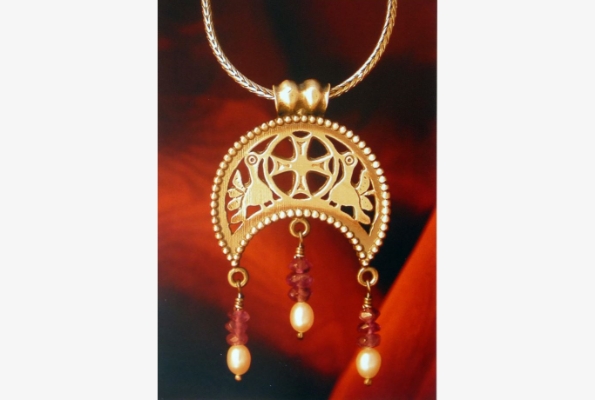
Home » Research & development » Pierced Byzantine Jewellery
PAVET 00 BE3 (pierced byzantine jewellery)
Design and Manufacturing of pierced Byzantine jewelry using modern techniques of manufacturing engineering
PAVET 00 BE 3 is a research project co-funded by the General Secretariat for Research and Technology, Hellenic Ministry of Development in the frame of the Operational Programme for Competitiveness.
Project Code: PAVET 00 BE3
Start date: 01-Sept-2001
Duration: 24 months
Collaborator: Univ. of Ioannina
The Object of the Research
The object of the research is to study the possibility to construct pierced Byzantine jewels using modern means of metallurgy and mechanical engineering. In particular, the study will include an investigation concerning the design and construction of pierced objects with the layering method, bearing of course in mind the limitations and characteristics posed by the hand-made practice.
Special attention will be paid to that kind of pierced jewels that involve a third dimension in their design.
The aforementioned results will be used for the software development that will serve to the automated design and production of pierced Byzantine Jewels according to the traditional methods.
Background
Golden jewels with pierced decoration are a special kind of jewellery that existed during the Roman and the early Byzantine period in the Mediterranean coastline. Their originality stems from their special working techniques and the exceptional impression they make.
Pierced Byzantine jewels were constructed by matching various holes, made with special tools, that corresponded to trihedral or polyhedral approaches of conic sections. Particular interesting are the pierced jewels with a third dimension. The process of the embossed third dimension was very difficult and required several extra stages. Within the centuries, the art of pierced jewellery had faded away, so today we only have little information about their technical construction.
Scientific aims
The program aims to the construction of pierced Byzantine jewels using modern means of metallurgy and mechanical engineering. More specific, we will design and construct pierced Byzantine jewels using the layering method, paying though much attention to the limitations and characteristics of the traditional hand-made piercing that was used in the case of Byzantine jewels.
For the automated design and construction of pierced Byzantine jewels according to the traditional art, a new special software application will be developed. The desired shape and characteristics of the jewel will be first determined in a special design system, which will then try to automatically define a possible placing of triangular cuts that will finally result in the desired shape according to the traditional art.
In the end, some experimental pieces of pierced Byzantine jewels will be constructed. Using the software application, STL files will be created, which then will be used to the layering method in order to produce the experimental parts.




